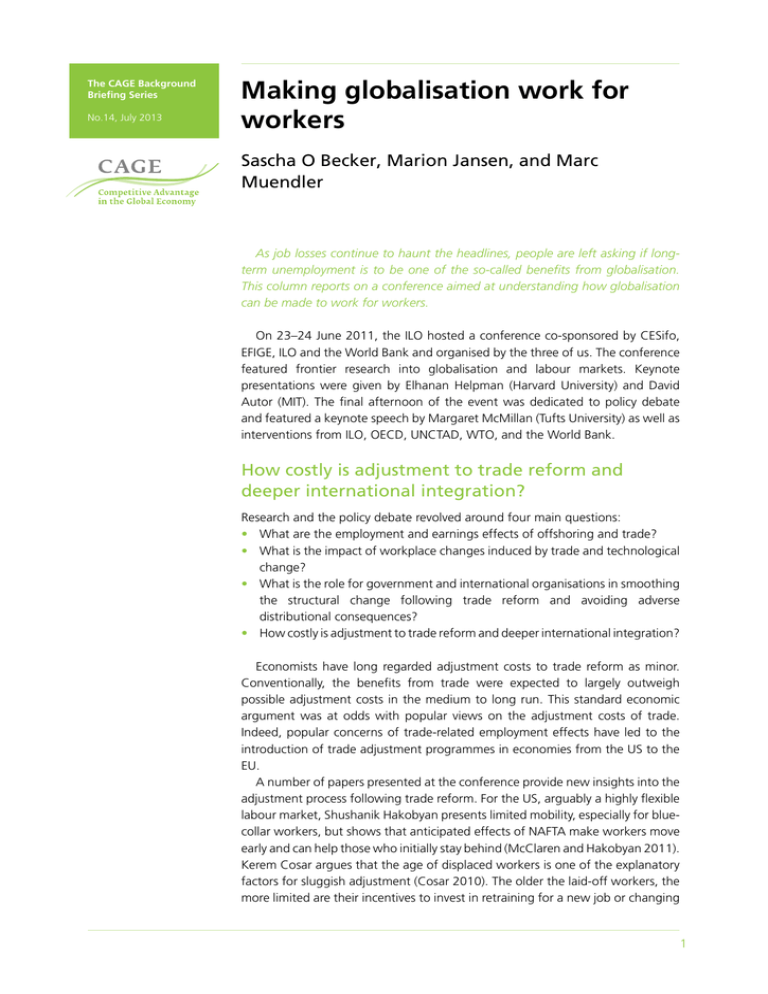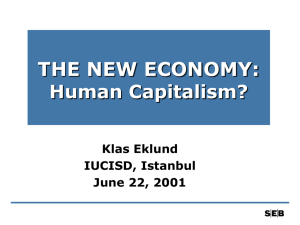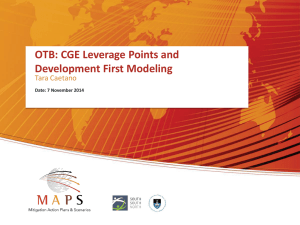Making globalisation work for workers Sascha O Becker, Marion Jansen, and Marc Muendler
advertisement

The CAGE Background Briefing Series No.14, July 2013 Making globalisation work for workers Sascha O Becker, Marion Jansen, and Marc Muendler As job losses continue to haunt the headlines, people are left asking if longterm unemployment is to be one of the so-called benefits from globalisation. This column reports on a conference aimed at understanding how globalisation can be made to work for workers. On 23–24 June 2011, the ILO hosted a conference co-sponsored by CESifo, EFIGE, ILO and the World Bank and organised by the three of us. The conference featured frontier research into globalisation and labour markets. Keynote presentations were given by Elhanan Helpman (Harvard University) and David Autor (MIT). The final afternoon of the event was dedicated to policy debate and featured a keynote speech by Margaret McMillan (Tufts University) as well as interventions from ILO, OECD, UNCTAD, WTO, and the World Bank. How costly is adjustment to trade reform and deeper international integration? Research and the policy debate revolved around four main questions: • What are the employment and earnings effects of offshoring and trade? • What is the impact of workplace changes induced by trade and technological change? • What is the role for government and international organisations in smoothing the structural change following trade reform and avoiding adverse distributional consequences? • How costly is adjustment to trade reform and deeper international integration? Economists have long regarded adjustment costs to trade reform as minor. Conventionally, the benefits from trade were expected to largely outweigh possible adjustment costs in the medium to long run. This standard economic argument was at odds with popular views on the adjustment costs of trade. Indeed, popular concerns of trade-related employment effects have led to the introduction of trade adjustment programmes in economies from the US to the EU. A number of papers presented at the conference provide new insights into the adjustment process following trade reform. For the US, arguably a highly flexible labour market, Shushanik Hakobyan presents limited mobility, especially for bluecollar workers, but shows that anticipated effects of NAFTA make workers move early and can help those who initially stay behind (McClaren and Hakobyan 2011). Kerem Cosar argues that the age of displaced workers is one of the explanatory factors for sluggish adjustment (Cosar 2010). The older the laid-off workers, the more limited are their incentives to invest in retraining for a new job or changing 1 Making globalisation work for workers location. Older workers are therefore more likely to remain unemployed, which in turn is costly for society. Kerem Cosar presents a calibration of his model to Brazil, arguably a less flexible economy. He points out that it would take 34 years in Brazil’s case for half of the displaced workers from declining import-competing sectors to complete their move to expanding export jobs. Economists have always accepted that trade reform can trigger adjustment costs in the short run and will have distributional effects in the long run. These effects were rarely considered an argument against trade reform; the overall gains from trade in the long run should instead be used to remedy undesirable effects with appropriate policy measures. Economists have, however, lacked the empirical apparatus to measure the magnitudes of these costs and to evaluate potential inefficiencies from government intervention. In his keynote speech, David Autor addressed possible inefficiencies and argued that the inefficiencies may wipe out welfare gains from trade to a large extent. Autor and his co-authors estimate that rising Chinese import competition explains 25% of the US manufacturing employment decline between 1991 and 2000, and 41% of the decline between 2000 and 2007 (Autor et al. 2007). Using local labour markets as their unit of analysis, Autor and his co-authors find that import exposure spurs a substantial increase in transfer payments to individuals and households in the form of unemployment insurance benefits, disability benefits, income support payments, and in-kind medical benefits. Their estimates imply that the losses in economic efficiency from trade-induced increases in the usage of public benefits are, in the medium run, of the same order of magnitude as US consumer gains from trade with China. This highlights that policymakers face an important dilemma. What are the employment and earnings effects of offshoring and trade? Trade today is less and less about exchanging final products. Instead, trade increasingly takes the form of trade in intermediates—often within the same multinational firm—as individual production stages are offshored. Indeed, most offshoring firms are also exporters (as Francis Kramarz points out in his work on France in Eaton et al. 2001), and most exporters are also importers. Francis Kramarz and his co-authors document that importing makes firms more competitive in product markets and more successful exporters, which breaks the conventional dichotomy between import competition and export success that dominated much of the economics used in public discourse. Exporters earn significant export premia, which they share with their workers broadly across skill groups. Given the importance of imports for export-market success, export wage premia are, according to Kramarz, closely linked to offshoring. Offshoring may well be a significant contributor to increased inequality, in particular in industrialised countries. Several presentations at the conference support this inference. Maarten Goos and Anna Salomons argue that offshoring may be related to the phenomenon of job polarisation observed in Europe (and also in the US and Brazil, see Goos et al. 2011). Job polarisation describes the phenomenon that employment increases relatively faster at both extremes of the skill distribution—for highly paid professionals and low paid personal services— while employment for the middle skill range decreases, including manufacturing and office workers who are paid around the mean wage. In simulations based 2 Making globalisation work for workers on a general equilibrium model of trade in tasks, Rojas-Romagosa finds that offshoring is most likely to lead to increased wage inequality in rich countries (in particular if they are large) and to reduced wage inequality in poor countries— the converse of implications of the classic theory of trade in final goods (RojasRomagosa 2011). The finding of increasing inequality in rich countries is also reflected in Margaret McMillan’s presentation, in which she points to significant employment reallocation in the US in response to import competition and offshoring. Her work with co-authors suggests that both import competition and offshoring are associated with a reduction of manufacturing employment. Workers who leave US manufacturing to take jobs in the US services sector suffer from a wage decline of between 6% and 22%. Elhanan Helpman points out, though, that there is no simple linear relationship between inequality and trade exposure in new trade theories, in particular those based on heterogeneous firms (Helpman et al. 2011). In relatively closed economies, more trade raises inequality. In relatively open economies, more trade reduces inequality as more and more firms trade. The rationale is intuitive and based on his recent work with co-authors—once all firms become exporters, all employers of a certain skill are paid the same wage. Even in the absence of offshoring, models with diverse employers can thus explain the observation that increases in inequality have often followed trade reform in developing countries. What is the impact of workplace changes induced by trade and technological change? Much of the previous economic literature in labour and trade has tended to treat trade and technological change as separate phenomena, and much empirical work was designed to discern whether skill-biased technological change is a more important driver of inequality than trade. That distinction may be artificial, as several presentations point out. Jonathan Vogel reports that a large share of imports is shipments of capital goods. In joint work with co-authors (Burstein et al. 2011), Jonathan Vogel deals explicitly with the labour market effects of “importing skill-biased technological change”. Simulations of their model suggest that, absent international trade in both capital equipment and manufactures, the skill premium would be roughly 5% smaller in the US and 16% smaller in the median country in their sample. The decrease would be much greater for countries that depend heavily on imported capital equipment, such as Cameroon or the Czech Republic. Carl Davidson and Susan Zhu look at an entirely different source of efficiency gains. They show that, in Sweden, increasing exposure to globalisation leads to more assortative matching. That is, more productive firms attract more skilled workers, and more skilled workers prefer to work for more productive employers with export activities. This matching of similar with similar offers an extra efficiency gain as trade strengthens matching in the export sector and heightens income inequality, but assortative matching in the import-competing industry may worsen. Jeanne Tschopp points out that the traditional focus on changes between sectors in reaction to labour demand shocks gives an incomplete picture of the adjustment processes. Changes between occupations might be equally important. In the case of Germany, a region’s average wage response to a shock to labour demand would be underestimated by two-thirds when ignoring interoccupational labour adjustments. 3 Making globalisation work for workers What is the role for government and international organisations in smoothing the structural change following trade reform and averting adverse distributional consequences? Several studies presented at the conference find that real individual incomes may decrease, even in a context of increasing real incomes for the average household. Reductions in real household income can stem from falling wages of employed household members or by changes in the risk and duration of unemployment. Unemployment risk matters particularly in the short run following trade reform, and several papers presented at the conference address relevant policy issues. Elhanan Helpman laid out implications of his joint work with co-authors on equilibrium unemployment in his keynote address. Under matching frictions in the labour market, he shows that unemployment benefits, or employer subsidies, can raise employment and thus economic efficiency in addition to mitigating distributional consequences. Kerem Cosar’s work implies that unemployment benefits can help short-run adjustment because they help individuals undertake the move to new activities despite an initial wage cut. Kerem Cosar's research also serves as a warning, however, that workers move slowly between activities not just because there are search costs, but largely because sector-specific skills and experience can be lost in transitions. He argues that employment subsidies are a more effective tool to address foregone returns to sector-specific skills because employment subsidies raise workers’ incentives to invest in new skills. Elhanan Helpman’s work also illustrates that there can be beggar-thy-neighbour effects from labour-market interventions in individual countries, as labour-market reforms can change countries’ comparative advantage. A country’s unilateral policies to reduce labour-market frictions generally increase the country's welfare, and may raise or reduce its unemployment rate, but unilateral labourmarket interventions generally harm the welfare of the country's trade partners. Elhanan Helpman’s findings therefore provide a rationale for coordination in labour-market policies across countries. The widely similar findings on the incidence of unemployment and slow reallocations after trade integration inevitably raise questions about the role of education and training policies in open economies. Presentations by Mario Larch and Giordano Mion explore aspects of this crucial policy issue. They show, respectively, how skill shortages can restrict export-market participation and how managerial expertise with exporting is spread through the economy as managers change employment. Yet it remains an important open question how endogenous skill acquisition can mitigate skill shortages and how education policies and vocational training systems can provide resources and consistent incentives. Much remains to be done in theoretical and empirical economic research in this regard. 4 Making globalisation work for workers References Autor, David, David Dorn and Gordon Hanson (2011), “The China Syndrome: Local Labor Market Effects of Import Competition in the United States.” Burstein, Ariel, Javier Cravino, and Jonathan Vogel (2011), “Importing SkillBiased Technology.” Cosar, Kerem A (2010), “Adjusting to Trade Liberalization:Reallocation and Labor Market Policies.” Davidson, Carl, Fredrik Heyman, Steven Matusz, Fredrik Sjoholm, and Susan Zhu (2010), “Globalization and Imperfect Labour Market Sorting.” Eaton, Jonathan, Samuel Kortum, Francis Kramarz and Raul Sampognaro (2011), “Wages, Employment, and Trade.” Goos, Martin, Alan Manning and Anna Salomons (2010), “Explaining Job Polarization in Europe: The Roles of Technology, Globalization and Institutions”, CEP Discussion Paper No 1026 Helpman, Elhanan, Oleg Itskhoki and Stephen Redding (2011), “Trade and Labour Market Outcomes”, NBER Working Paper 16662. Holzner, Christian and Mario Larch (2011), “Capacity Constraining Labor Market Frictions in a Global Economy.” Jain, Sanjay, Sumon Majumdar and Sharun W. Mukand (2010), “Workers Without Borders? Culture, Migration and the Political Limits to Globalization.” Mion, Giordano and Luca Opromolla (2011), “Managers’ Mobility, Trade Status, and Wages.” McLaren, John and Shushanik Hakobyan (2011), “Looking for Local LaborMarket Effects of the NAFTA.” Rojas-Romagosa, Hugo (2011), “Wage inequality in trade-in-tasks models.” Tschopp, Jeanne (2011), “The Wage Response to Shocks: The Role of InterOccupational Labor Adjustment.” Editors’ note: These papers were included in the proceedings of Globalization and Labour Market Outcomes academic workshop, 23–24 June 2011 at ILO, Geneva. Individual papers and presentation slides are available at http://www.ilo.org/employment/ Whatwedo/Eventsandmeetings/WCMS_156332. Video statements by conference participants can be seen on YouTube at http://www.youtube.com/ watch?v=ZmtYQSYJU2E. 5 About CAGE Established in January 2010, CAGE is a research centre in the Department of Economics at the University of Warwick. Funded by the Economic and Social Research Council (ESRC), CAGE is carrying out a five-year programme of innovative research. The Centre’s research programme is focused on how countries succeed in achieving key economic objectives, such as improving living standards, raising productivity and maintaining international competitiveness, which are central to the economic well-being of their citizens. CAGE’s research analyses the reasons for economic outcomes both in developed economies such as the UK and emerging economies such as China and India. The Centre aims to develop a better understanding of how to promote institutions and policies that are conducive to successful economic performance and endeavours to draw lessons for policy-makers from economic history as well as the contemporary world. This piece first appeared on Voxeu on 1 October 2011. www.voxeu.org/article/making-globalisation-work-workers © 2013 The University of Warwick. Published by the Centre for Competitive Advantage in the Global Economy Department of Economics, University of Warwick, Coventry CV4 7AL www.warwick.ac.uk/cage Designed and typeset by Soapbox, www.soapbox.co.uk







